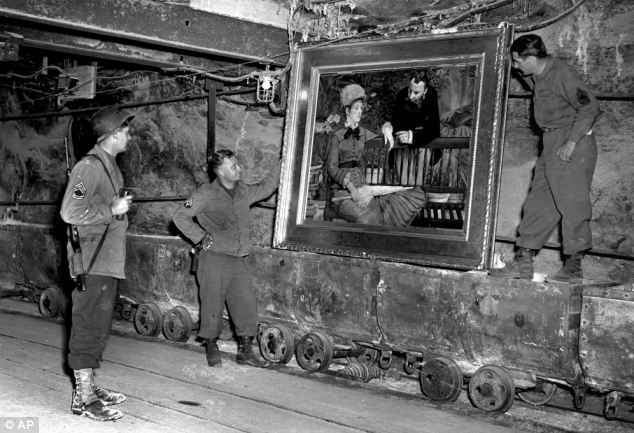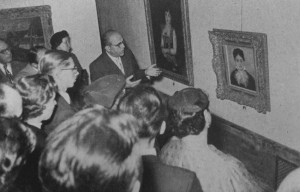by Susan Ronald
Hildebrand Gurlitt
When I stepped into a large, Swiss bank vault in 1998 in my previous life as an investment banker, I had no idea that I would see a tiny portion of one of the greatest private looted art hoards of World War II. Hildebrand Gurlitt, one of Hitler’s four horsemen of the art apocalypse wrought on Europe’s museums and citizenry, had magically gone unnoticed by the world at large. Yet he succeeded in running rings round the Monuments Men and Hitler alike. It seems odd to me now that I knew some fifteen years before the news broke that Gurlitt had squirreled away tens of thousands of works of looted art into Swiss vaults and other hiding places. It was only in the writing of the book that I discovered he not only hid his own ill-gotten gains but also those of the Nazi elite.

How did this man from a distinguished family with generations of artists and musicians swelling their family tree become Hitler’s art thief? The road was a pitted and winding one, full of figurative land mines, of course. The horrors of World War I led to a series of nervous breakdowns, self-inflicted wounds and temporary “respite” as a German Monuments Man in Belgium before becoming a writer of dispatches from the Eastern Front at Vilnius. His war experiences had taught him to be “flexible” in his beliefs, helping him to reason away any moral dilemmas that may have troubled him. Nonetheless, Gurlitt’s undoing was down to his colossal ego and his overblown dedication to Pan-German-ism. The former was almost understandable given the context of his family’s significance in the art world – the latter was one of the root causes of two world wars.
It was only in 1925 – when Hildebrand Gurlitt was thirty years old – that he found his first steady job as a museum director in Zwickau. He had been passed over time and again for other candidates to fill positions in Dresden, the beloved city of his birth, as well as elsewhere. Essentially, Hildebrand Gurlitt seemed to be unlikable and unemployable by the new museum elite. Yet he continued to believe unerringly in his superiority. Once in Zwickau, he sought to shake up his old-fashioned and staid museum with German Expressionist artworks. Meanwhile, his father, the university lecturer and architectural historian, Cornelius, led his entire family to the inescapable conclusion that Pan-German-ism, uniting all German-speaking peoples as superior to other nationalities, was an untarnished creed. By 1930, Pan-Germanism’s most outspoken politician became Adolf Hitler and his Nazi movement. Both generations of Gurlitts voted for Hitler in the 1933 elections. Both believed Hitler would save Germany from economic and social ruin. Neither realized that they would be deemed Mischlings – or inferior humans of mixed race because Hildebrand’s grandmother was Jewish.

Shortly before the move to Zwickau, Gurlitt married Helene Hanke, a Mary Wigman modern dancer. This coincided with his sudden preoccupation with making lots of money – primarily selling modern art to the industrialist patrons of his Zwickau museum. Gurlitt’s most significant benefactor became Kurt Kirchbach, the king of all vehicle brake manufacturing in Germany. When Gurlitt’s museum was forced to close by the disapproving Nazi Gauleiter of Saxony, Kirchbach set him up in business as an art dealer; and Gurlitt never looked back. As early as 1936, Hildebrand Gurlitt engineered his way into the role of one of the four official dealers handling the spoils of expressionist and modern art taken from museums in Germany, as well as any art “bought” at a huge discount from Germany’s fleeing citizens in exchange for exit visas.
While he claimed to loathe the Nazis as philistines, Gurlitt enriched himself at their expense. As early as December 1940, he was touting church windows to Göring for a Christmas present. He became a close personal friend of Albert Speer; an official art dealer to the Führermusem in Linz; and the “go to” man to remove art to secret hideaways in the closing days of the war. By the end of the war, he had become the most prolific looter of France in the name of Hitler and Linz.
By March 1945, Hitler’s accountants were hot on his trail, suspecting Gurlitt of stealing from the Führer. Still, in the scrimmage to hide art stolen for and from Hitler, Hildebrand Gurlitt proved to be the most adept at clandestine operations. I have many reasons to believe after writing the book that the treasure troves found in Munich and Salzburg are merely the proverbial tip of the iceberg.
Born and raised in the United States, SUSAN RONALD is the author of HITLER’S ART THIEF: Hildebrand Gurlitt, the Nazis, and the Looting of Europe’s Treasures. She has consulted for five British government departments and The National Trust, and in addition to Hitler’s Art Thief,she is the author of Heretic Queen: Queen Elizabeth I and the Wars of Religion, Shakespeare’s Daughter (a novel), The Pirate Queen, The Sancy Blood Diamond, and France: Crossroads of Europe. She also owns a film production company and is a screenwriter and film producer.
